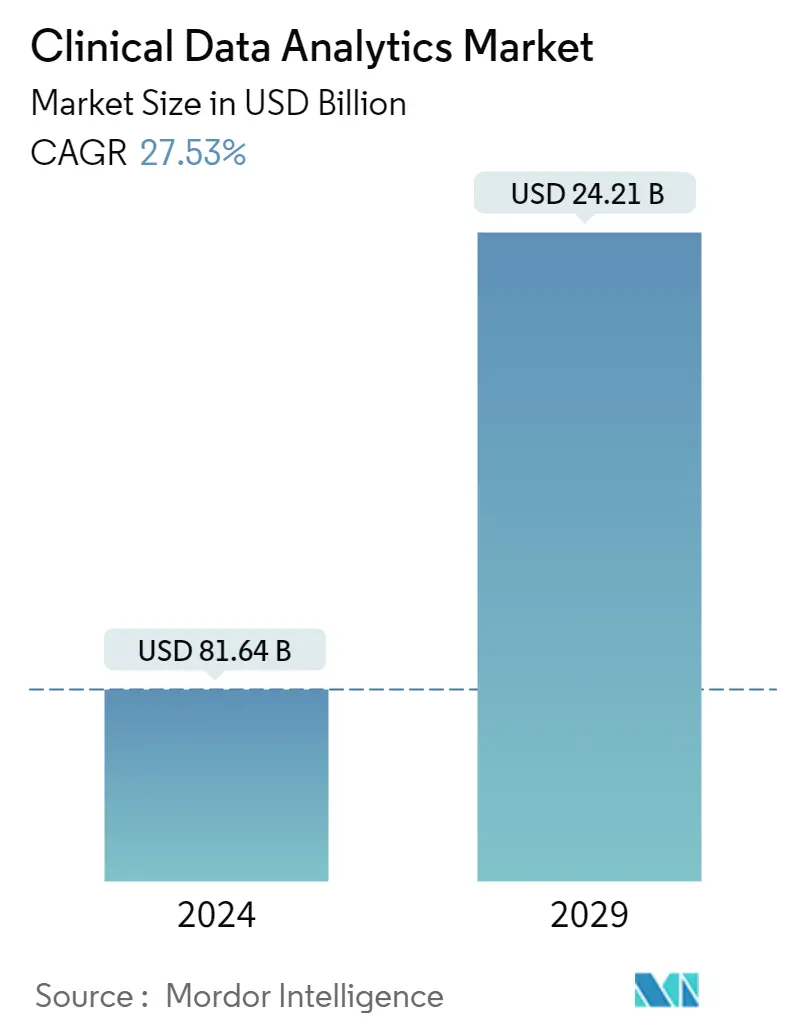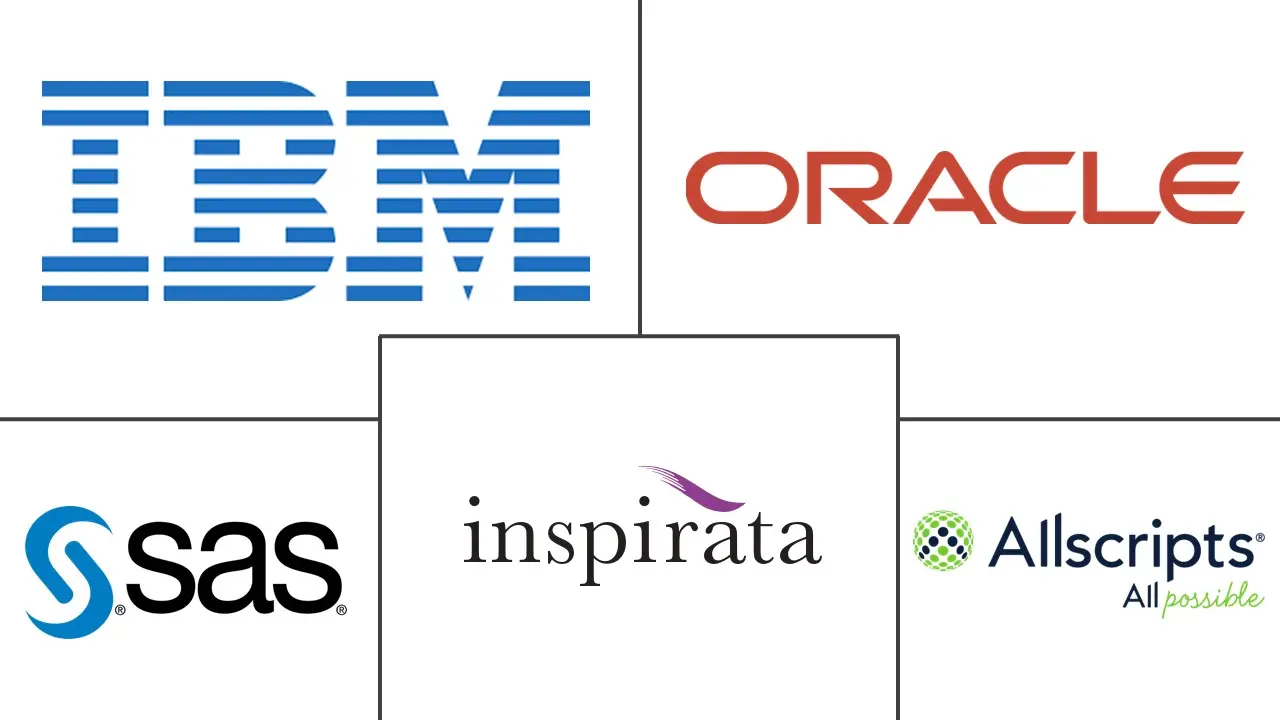Market Size of Clinical Data Analytics Industry

| Study Period | 2019 - 2029 |
| Market Size (2024) | USD 81.64 Billion |
| Market Size (2029) | USD 24.21 Billion |
| CAGR (2024 - 2029) | 27.53 % |
| Fastest Growing Market | Asia Pacific |
| Largest Market | North America |
Major Players
*Disclaimer: Major Players sorted in no particular order |
Clinical Data Analytics Market Analysis
The Clinical Data Analytics Market size is estimated at USD 81.64 billion in 2024, and is expected to reach USD 24.21 billion by 2029, growing at a CAGR of 27.53% during the forecast period (2024-2029).
- Clinical data analytics within the healthcare industry is crucial for the treatment and prediction of illnesses, enhancing the level of care, and reducing avoidable deaths caused by the oversight of certain chronic conditions. Information provided by users, measurements from task-based devices, and data from passive sensing all contribute to the gathering of data utilized for clinical data analysis, ultimately aiding in the expansion of the market.
- Clinical data analytics play a vital role in clinical research, involving the storage, collection, and analysis of data to enhance its utilization. This enables healthcare facilities to deliver personalized and preventive care efficiently. The advancements in clinical, healthcare, and data analytics technologies have significantly impacted the industry. Moreover, the ever-changing regulations in the industry contribute to market dynamics, pushing for cost reduction in drug development and the need for innovative therapies.
- Clinical data analysts are also tasked with the development and management of healthcare databases, as well as providing training for software and technical programs. They design secure systems for data storage and keep abreast of regulations to ensure compliance with ethical standards. Clinical data analysts play a key role in ensuring the smooth operation of networks and overseeing necessary upgrades. The growing demand in the healthcare industry is anticipated to boost market demand.
- Over the last few years, there has been a growing emphasis on managing diabetes. A recent study by Rensselaer Polytechnic Institute utilized artificial intelligence (AI) and big data analytics to analyze data from numerous continuous glucose monitors and insulin pumps. The findings from this research can help enhance the algorithms governing these devices, ultimately benefiting individuals with type 1 diabetes. By incorporating technology into diabetes management, there is a possibility of delivering superior diabetes care, reducing expenses and administrative complexities, and empowering individuals with diabetes and their caregivers.
- The increasing need for customized medical treatments and diagnostic tests has resulted in a significant rise in clinical trials. These trials produce large amounts of data, requiring sophisticated clinical data analytics solutions to extract valuable insights. Additionally, factors such as government support, global investments, and advancements in the healthcare industry by major players across various countries like India, Japan, the United States, and the EU States will create numerous opportunities for market growth.
- Anticipated advancements from industry vendors are projected to boost the market's growth prospects in the upcoming years. In June 2024, Medidata, a brand under Dassault Systèmes and a prominent supplier of clinical trial solutions to the life sciences industry, introduced Medidata Clinical Data Studio. This innovative platform offers a cohesive interface that unleashes the full potential of clinical research data. Through this cutting-edge technology, stakeholders are empowered with enhanced data quality control and the capability to expedite the delivery of safer trials to patients.
- As a result, the increasing quantity of clinical trials is driving the need for more sophisticated clinical trial solutions. Nonetheless, a prevalent issue faced by data analysts is poor data quality, which can impede analysis and decision-making, potentially impacting market growth.
- The COVID-19 pandemic accelerated the integration of digitalization into the market, leading to an increased emphasis on remote patient care, consultations, and diagnoses. Additionally, the pandemic caused a substantial surge in the market as a result of digitalization. However, the growing prevalence of cardiac diseases during the pandemic, influenced by various external factors, is also expected to fuel the growth of the clinical data analytics market in the forecast period.
Clinical Data Analytics Industry Overview
Clinical data analytics assist physicians in better managing a patient's health condition and understanding their health status. The technology can vary depending on the data involved, the users of the information, or the actions taken at the discretion of decision-makers such as nurses, doctors, public health officials, and senior management.
The clinical data analytics market is segmented by deployment model, application, end-user vertical, and geography. By deployment mode, the market is segmented into cloud and on-premise. By application, the market is segmented into quality improvement and clinical benchmarking, clinical decision support, regulatory reporting and compliance, comparative analytics/comparative effectiveness, and precision health. By end-user vertical, the market is divided into payers and providers. By geography, the market is segmented into North America, Europe, Asia-Pacific, the Middle East and Africa, and Latin America. The market sizes and forecasts are provided in terms of value (USD) for all the above segments.
| By Deployment Model | |
| Cloud | |
| On-premise |
| By Application | |
| Quality Improvement and Clinical Benchmarking | |
| Clinical Decision Support | |
| Regulatory Reporting and Compliance | |
| Comparative Analytics/Comparative Effectiveness | |
| Precision Health |
| By End-user Vertical | |
| Payers | |
| Providers |
| Geography | ||||||||
| ||||||||
| ||||||||
| ||||||||
| ||||||||
|
Clinical Data Analytics Market Size Summary
The clinical data analytics market is experiencing significant growth, driven by its critical role in enhancing healthcare outcomes through disease prediction and management. The integration of user-reported data, task-based measures, and passive sensing is facilitating the collection of valuable data for analysis, which is propelling market expansion. The industry is also influenced by evolving regulations, the need to reduce drug development costs, and the increasing demand for innovative therapies. The market is witnessing a shift towards electronic data recording systems and advanced methodologies, such as randomized trials, which are creating new opportunities. The focus on diabetes management, supported by studies utilizing artificial intelligence and big data analytics, exemplifies the market's potential to improve patient care through technology-driven solutions.
The adoption of cloud-based solutions is transforming the clinical data analytics landscape by enabling secure, collaborative, and efficient data management across multiple locations. These solutions are particularly beneficial in handling the vast amounts of data generated by genomic medicine, offering cost-effective storage and advanced computing power for accurate insights. The North American market is poised for substantial growth, fueled by federal healthcare mandates, increased EHR adoption, and government initiatives in personalized medicine and population health management. The market is semi-consolidated, with key players expanding their global presence through strategic collaborations. Recent developments, such as AI-powered analytics and digital health information channels, highlight the ongoing innovation and investment in the sector, aiming to enhance healthcare delivery and outcomes.
Clinical Data Analytics Market Size - Table of Contents
-
1. MARKET INSIGHTS
-
1.1 Market Overview
-
1.2 Industry Attractiveness - Porter's Five Forces Analysis
-
1.2.1 Threat of New Entrants
-
1.2.2 Bargaining Power of Buyers/Consumers
-
1.2.3 Bargaining Power of Suppliers
-
1.2.4 Threat of Substitute Products
-
1.2.5 Intensity of Competitive Rivalry
-
-
-
2. MARKET SEGMENTATION
-
2.1 By Deployment Model
-
2.1.1 Cloud
-
2.1.2 On-premise
-
-
2.2 By Application
-
2.2.1 Quality Improvement and Clinical Benchmarking
-
2.2.2 Clinical Decision Support
-
2.2.3 Regulatory Reporting and Compliance
-
2.2.4 Comparative Analytics/Comparative Effectiveness
-
2.2.5 Precision Health
-
-
2.3 By End-user Vertical
-
2.3.1 Payers
-
2.3.2 Providers
-
-
2.4 Geography
-
2.4.1 North America
-
2.4.1.1 United States
-
2.4.1.2 Canada
-
-
2.4.2 Europe
-
2.4.2.1 Germany
-
2.4.2.2 United KIngdom
-
2.4.2.3 Italy
-
2.4.2.4 France
-
2.4.2.5 Spain
-
2.4.2.6 Rest of Europe
-
-
2.4.3 Asia-Pacific
-
2.4.3.1 India
-
2.4.3.2 China
-
2.4.3.3 Japan
-
2.4.3.4 South Korea
-
2.4.3.5 Australia
-
2.4.3.6 Rest of Asia-Pacific
-
-
2.4.4 Latin America
-
2.4.4.1 Brazil
-
2.4.4.2 Argentina
-
2.4.4.3 Rest of Latin America
-
-
2.4.5 Middle East and Africa
-
2.4.5.1 GCC
-
2.4.5.2 South Africa
-
2.4.5.3 Rest of Middle East and Africa
-
-
-
Clinical Data Analytics Market Size FAQs
How big is the Clinical Data Analytics Market?
The Clinical Data Analytics Market size is expected to reach USD 81.64 billion in 2024 and grow at a CAGR of 27.53% to reach USD 24.21 billion by 2029.
What is the current Clinical Data Analytics Market size?
In 2024, the Clinical Data Analytics Market size is expected to reach USD 81.64 billion.

